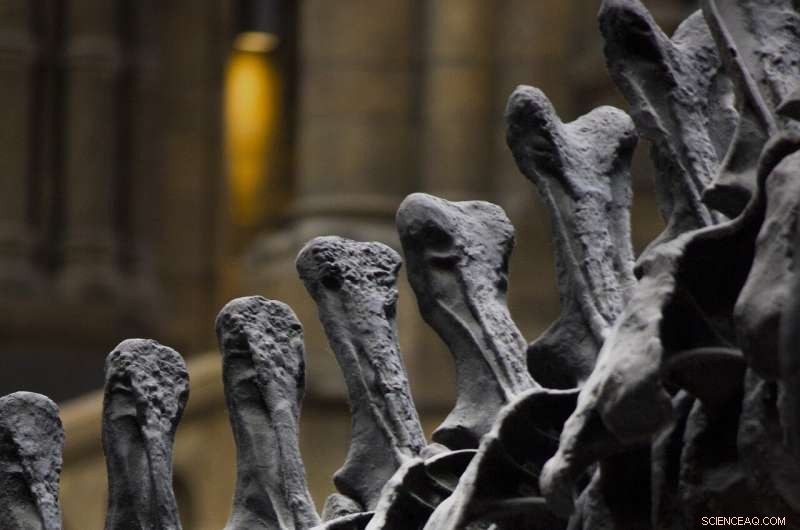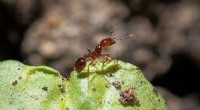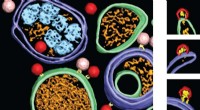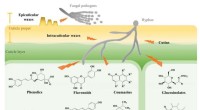Afslører denne dinosaurkirkegård deres sidste dag på jorden? En ekspert udforsker beviserne

Kredit:Pixabay/CC0 Public Domain
Begravet i klipperne i North Dakota ligger beviser for den nøjagtige dag, hvor dinosaurerne blev udslettet fra planeten, for omkring 66 millioner år siden. Det er påstanden fra palæontolog Robert DePalma og kolleger, hvis arbejde blev fanget af BBC i sin nylige skelsættende dokumentar "Dinosaurs:The Final Day with David Attenborough."
I de sidste ti år har DePalma fokuseret sit arbejde på et fossilrigt sted - som han har kaldt "Tanis" - i North Dakotas Hell Creek Formation. Og siden 2019 har han og hans kolleger fremsat nogle meget stærke påstande om, hvad Tanis fortæller os om slutningen af kridtperioden.
DePalma mener, at Tanis er en massekirkegård af skabninger, der blev dræbt under asteroideangrebet.
Der er ingen tvivl om, at en asteroide førte til masseudryddelsen af ikke-fugle dinosaurer - og mindst 50% af andre arter - for 66 millioner år siden. Men der har været en del kontroverser omkring DePalmas påstand om, at stedet dokumenterer selve dagen, hvor asteroiden ramte - og afslører direkte beviser for de allersidste dinosaurer på Jorden.
Så lad os tage et kig på, hvad vi ved om denne vigtigste tid i vores planets historie – og hvad der stadig er usikkert.
Den enorme asteroidekollision
Da asteroide-nedslagsteorien først blev foreslået i 1980, var der intet krater. Det eneste bevis var to steder med væsentlig berigelse af iridium - et grundstof, der ankommer til Jordens overflade fra det ydre rum - i klipperne nøjagtigt i niveau med slutningen af Kridttiden.
Nu er der hundredvis af steder verden over, der viser iridium-spidsen, ved det, der er kendt som K-Pg-grænsen (Kridt-Paleogen), en geologisk signatur i sedimentet.
Og så i 1991 kom det store gennembrud – Chicxulub-krateret blev fundet i det, der nu er Yucatán-halvøen i det sydlige Mexico.
Ved 180 km (110 miles) bred og 20 km (12 miles) dyb viser krateret, at en enorm 10 km (seks miles) bred asteroide styrtede ned i havet. Dens kraft var så stor, at den udløste enorme tsunamibølger såvel som massive mængder stenaffald og støv indeholdende iridium i atmosfæren – og udløste også en kraftig hedebølge.
De fleste eksperter er enige om, at alt liv inden for omkring 1.700 km (1.000 miles) fra kollisionen ville være blevet udslettet øjeblikkeligt.
Men Tanis var mere end 2.800 km (eller 1.800 miles) væk. Og indtil nu var der ingen beviser for de allersidste dinosaurer. Så hvad er grundlaget for DePalmas banebrydende afsløring af, at Tanis endelig giver det uhåndgribelige bevis på dinosaurernes sidste dag?
Asteroidebevis ved Tanis
Der er næppe tvivl om, at Tanis-stedet ligger tæt på slutningen af Kridtperioden, fordi DePalma har identificeret iridiumlaget umiddelbart over det fossile leje, som placerer det ved K-Pg-grænsen.
Han har også fremlagt nogle overbevisende beviser på, at stedet markerer den nøjagtige dag, hvor asteroiden ramte.
First, there are the ancient channels in the sedimentary rocks at Tanis—these are evidence of the huge standing water (or "seiche") waves which engulfed Tanis. At that time North America was divided by a great seaway that passed close to the Tanis site:the seiche waves would have run up the creeks, and out again, several times, mixing fresh and sea waters to create the waves.
The ground-borne shock waves from the asteriod impact—which caused the devastating water surges—could readily travel through the Earth's crust from the impact site to Tanis.
When the asteroid crashed into Earth, tiny ejector spherules, glassy beads about 1mm wide, were formed from melted molten rock—and were able to travel up to around 3,200km (2,000 miles) through the atmosphere because they were so light.
Astonishingly, DePalma found these glassy spherules at the site, and also in the gills of sturgeon fossils which occupied the Tanis streams. He believes the spherules were produced by the Chicxulub impact because of their shared chemistry, with some even encapsulating "fragments of the asteroid" itself. If this is true, their occurrence at Tanis would indeed confirm that they mark the actual day of impact, because the spherules would have fallen to the ground within hours of the impact.
Tanis fossil findings
From decades of study of the rocks and fossils at Hell Creek Formation, we know that Tanis was a warm and wet forest environment, with a thriving ecosystem full of dinosaurs, pterosaurs (flying reptiles), turtles and early mammals. Although they are yet to be described in detail, DePalma and colleagues reveal some incredible new fossils of animals—and he believes they could well have died on the day of the impact itself, due to their location in the doomed Tanis sandbank.
First, there's an exceptionally preserved leg of the herbivorous dinosaur Thescelosaurus, which shows not only the bones, but also skin and other soft tissues.
But that's not all. There is a pterosaur baby, just about to hatch from its egg—and, some incredibly well preserved Triceratops skin, which is an extremely unusual find.
Even more astonishingly, there is a turtle impaled by a stick, which DePalma believes could be evidence of a tragic death in the turbulent seiche waves set off by the impact.
DePalma's final claim is that the impact, and final day, occurred in May, based on microscopic and geochemical analysis of growth rings in the fin spines of the fossil sturgeon. The bones show seasonal banding—where bone grows rapidly when food is abundant and slowly when conditions are poorer, so often summers are shown by a wide pale band and winters by a narrow dark band. The last banding cycle in the sturgeon confirms it died in May. And a further study this year has confirmed this.
So why the uncertainty?
There is no doubt that DePalma's claims have been controversial since they were first presented to the world in 2019—probably because the announcement was in the New Yorker magazine rather than a peer-reviewed journal.
But the findings about seiche waves were then published in an academic paper only a month later, and most geologists were convinced.
It is true that the fossils, which were revealed for the first time in the BBC documentary—along with the evidence that the glass spherules at Tanis are linked to the Chicxulub impact—have yet to be published in scientific journals, where they would be subject to peer review.
But, experience shows that most of what DePalma has revealed in the past has been backed up subsequently by peer-reviewed papers.
Over the past two years I worked as one of the independent scientific consultants to the BBC, verifying the claims, as they made the documentary. Both I and my colleagues, and many other experts, are satisfied that the Tanis site probably does reveal the very last day of the non-avian dinosaurs.
And of course, as we all know, the impact of the asteriod went far beyond that one day. It led to a freezing dark planet, on a global scale, lasting for days or maybe weeks—and, from this mass extinction worldwide, the age of the mammals emerged.
 Varme artikler
Varme artikler
-
 Undersøgelse viser adfærdsmæssige, fysiologiske ændringer hos myrer forstyrret af udvikling, bys…Forskning fokuseret på ændringer i myrernes fysiologi og adfærd baseret på deres miljø håber at kunne kaste lys over andre myre- og dyrearter, der udvikler sig midt i urbaniseringen. Kredit:Texas A&M
Undersøgelse viser adfærdsmæssige, fysiologiske ændringer hos myrer forstyrret af udvikling, bys…Forskning fokuseret på ændringer i myrernes fysiologi og adfærd baseret på deres miljø håber at kunne kaste lys over andre myre- og dyrearter, der udvikler sig midt i urbaniseringen. Kredit:Texas A&M -
 Forskere frigiver verdens første DNA-kort over en truet australsk mus, og det vil hjælpe med at re…Kredit:David Paul, Museums Victoria, CC BY Den indfødte australske gnaver Pseudomys fumeus, kaldet røgmus for sin farve, kæmpede allerede mod udryddelse, da bushbrandsæsonen 2019-20 ramte. Den sor
Forskere frigiver verdens første DNA-kort over en truet australsk mus, og det vil hjælpe med at re…Kredit:David Paul, Museums Victoria, CC BY Den indfødte australske gnaver Pseudomys fumeus, kaldet røgmus for sin farve, kæmpede allerede mod udryddelse, da bushbrandsæsonen 2019-20 ramte. Den sor -
 Hvordan poliovirus overtager celler indefraDet venstre billede viser, hvordan nydannede polioviruspartikler (lyserøde) er fyldt med virusgenomet og bliver til infektiøse vira (røde). Til højre:hvis cellens protein VPS34 hæmmes, stopper virussa
Hvordan poliovirus overtager celler indefraDet venstre billede viser, hvordan nydannede polioviruspartikler (lyserøde) er fyldt med virusgenomet og bliver til infektiøse vira (røde). Til højre:hvis cellens protein VPS34 hæmmes, stopper virussa -
 Hvordan forsvarer havebrugsafgrøder sig mod svampepatogener?Fysiske barrierer og fytokemikalier involveret i gartneriafgrøders resistens over for svampepatogener. Kredit:Nanjing Agricultural University The Academy of Science For nylig opsummerede forskere f
Hvordan forsvarer havebrugsafgrøder sig mod svampepatogener?Fysiske barrierer og fytokemikalier involveret i gartneriafgrøders resistens over for svampepatogener. Kredit:Nanjing Agricultural University The Academy of Science For nylig opsummerede forskere f
- Appetitten på hjemmearbejde er steget siden pandemiens start, viser rapporten
- Astronomer opdager kæmpe relikvie fra den forstyrrede haletudsegalakse
- Simpel grafenkaskade giver hidtil uset indsigt i nanoionik
- Opvarmning af bygninger:Den overset klimaforandringsfaktor
- Koraller i grumset vand mindre påvirket af temperaturstress, forskningsfund
- Livscyklus for en Hammerhead Shark


